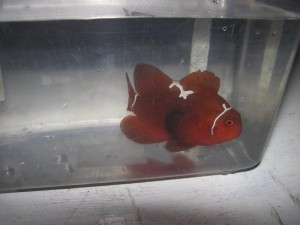Author Archives: William
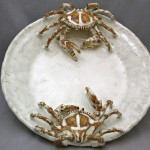
Ceramic Reef Art By Shayne Greco
This is not really aquarium related but it is kind of reef related and I thought it was rather neat. The ceramic art by Shayne Greco is good looking and made to be usable. I for one would love to have the octopus sink but would be afraid that it would break in shipping. The art is available in galleries around the nation and through his Etsy Shop.
Let us know what you think about this art by commenting below.
Thanks to advancedaquarist for bringing this to my attention.
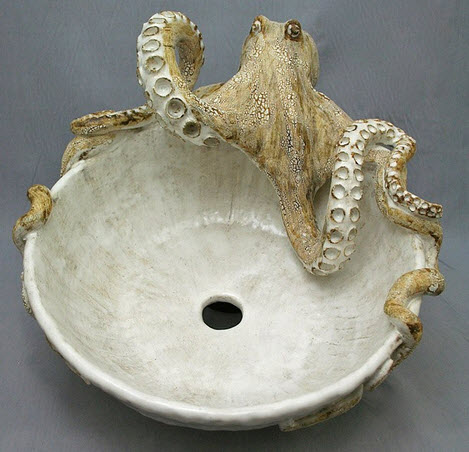
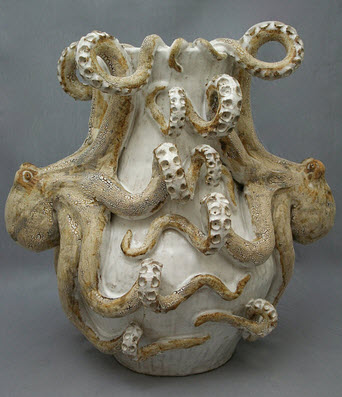
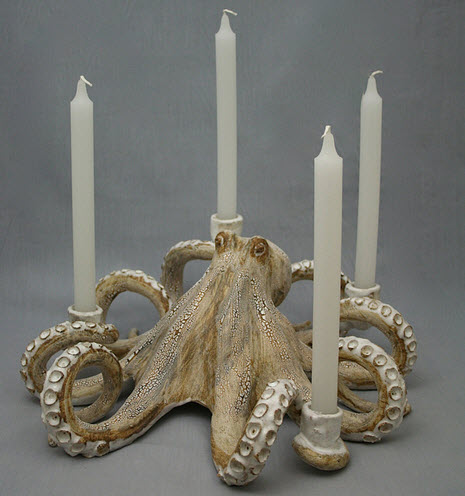
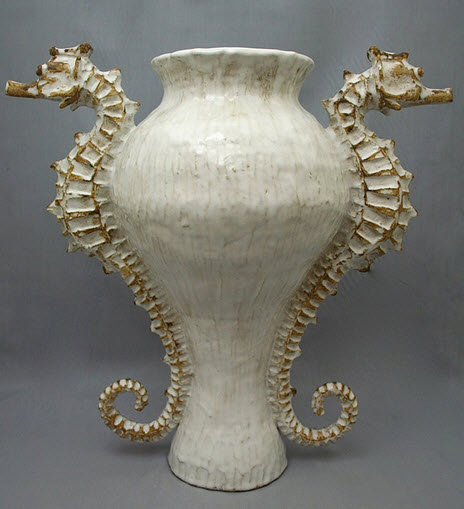
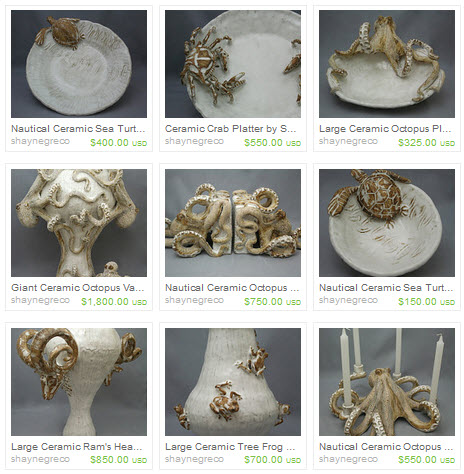
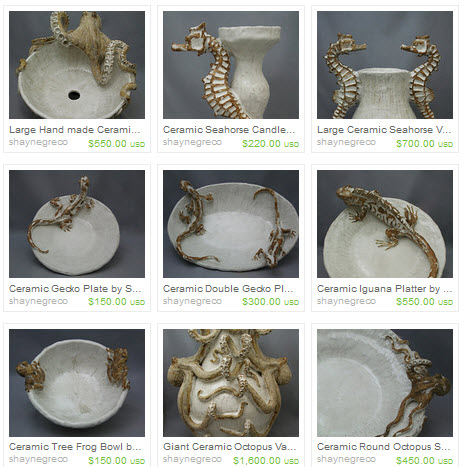
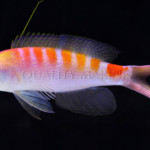
Unknown Anthias discovered in New Caledonia by fish collectors
Fish collectors in New Caledonia has found a species of Anthias previously unknown in the fish keeping hobby. The species has not been described scientifically and is thus without any scientific name. The collectors, working for marine fish wholesale importer Quality Marine, has dubbed the fish New Caledoina Sunrise Anthias as it is adorned with red-orange bars and hues of yellow and pink. Credit for first collecting this species goes to Antoine Teitelbaum, and credit for first seeing this species goes to Tony Nahacky.
“When first received by QM, we were unable to conclusively identify them as any of the known species,” Quality Marine explains in an official statement posted on their website. “Antoine and Tony reached out to a number of ichthyologists, some of whom have confirmed our suspicion that they are indeed a new species and are in the process of describing it for the scientific community.”
According to information provided by Quality Marine, the New Caledonia Sunrise Anthias is a deep water fish that forms large schools. Research indicates that the sex ratio within a school is 1:1. It is possible that the fish is endemic to New Caledonia. The New Caledonia Sunrise Anthia eats plankton just like other Anthias, and seems to chiefly feed on zooplankton and other meaty foods suspended in the currents.
Keeping The New Caledonia Sunrise Anthias in aquariums
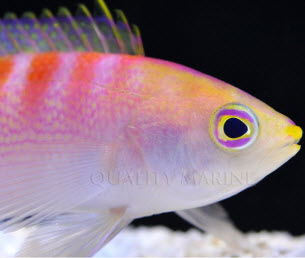
A cose up of the Caledonia Sunrise Anthias.
At Quality Marine, the collected New Caledonia Sunrise Anthias are currently being kept in two large schools. Dominant males and females can engage in some semi-violent behavior, but aside from this the school is peaceful.
“As a species, they seem to be less aggressive than many of the other Anthias this size. Because of our success in larger groups, they will likely be held like this in the future, and should be held in at least small groups (pairs, harems, etc) in the store display and home aquariums,” is the official advice provided by Quality Marine at this point.
As soon as the fish had acclimated, they started eating Nutramar OVA. After a day or so, they would also accept other meaty foods. They are now kept in on a diet of Nutramar OVA, enriched brine shrimp, Gamma mysis, krill, chopped prawn and other finely chopped meaty foods.
Probably a Pseudoanthias
Although the New Caledonia Sunrise Anthias has not be scientifically named yet, it can be tentatively placed in the genus Pseudoanthias. That would make it a close relative of species such as Sea Goldie (Pseudanthias squamipinnis), Bicolor Anthias (Bicolor anthias), Tiger Anthias ( Pseudanthias lori) and Two-spot Basslet (Pseudanthias bimaculatus).
The visual similarity between the New Caledonia Sunrise Anthias and other slender deep-water dwelling Pseudoanthias from the Pacific Ocean is easy to notice.
The New Caledonia Sunrise Anthias sports red vertical bars on the back, in a patter somewhat similar to the one displayed by Tiger Anthias ( Pseudanthias lori). The bars of the New Caledonia Sunrise Anthias are very wide and pronounced, and they reach halfway down the flank of the body. There is also a bright red saddle present at the base of the tail fin. Male specimens are normally more brilliantly colored than females, and males have a dorsal spine that proceeds far beyond the dorsal fin.
Buying New Caledonia Sunrise Anthias
Quality Marine will release the New Caledonia Sunrise Anthias on the aquarium market in the coming weeks. They do not sell directly to consumers, so fish keepers interested in keeping Sunrise Anthias need to contact marine fish stores and ask them to procure the fish for them.
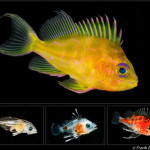
Hawaiian deepwater fish successfully reared from wild collected eggs
Odontanthias fuscipinnis, commonly known as Yellow Fin Anthias, is a much sought after deepwater fish endemic to the waters of Hawaii. It’s highly coveted by reef aquarists due to its striking coloration, and can cost $1 000 or more to procure.
In the future, captive raised Yellow Fin Anthias may start showing up in the trade, because marine fish expert Frank Baensch has now managed to rear wild collected eggs into nearly full grown fish in captivity. As far as we know, he is the first person to ever accomplish this feat. The species was reared as part of the Hawaii Larval Fish Project.
In December 2012, Baensch collected a small number of eggs from surface waters off Oahu and brought them to RCT Hawaii. When the eggs hatched, bright red larvae emerged.
“Features of the larvae include an elongated second dorsal spine and pelvic fin rays; pronounced head spination; brown pigment spots below the dorsal fin; and red pigment blotches on the body,” says the official blog of the Hawaii Larval Fish Project.
The larvae was kept in a 50 liter tank with multiple species and were fed wild caught Copepod nauplii plankton. According to Baensch, the larvae were robust in their 50 liter mixed species environment – good news for other marine aquarists interested in breeding or raising Yellow Fin Anthias.
As they matured over the course of 80 days, the larvae developed into small juvenile fish, lost their bright redness and started displaying the yellow coloration typical for adult Yellow Fin Anthias.
Odontanthias
Odontanthias is a genus of fishes in the subfamily Anthiinae in the family Serranidae. They inhabit rocky reefs and are found in deep waters; typically below 100 meters. A vast majority of the known species live in the Indo-Pacific, but Odontanthias hensleyi is native to the Caribbean
Just like other members of the subfamily Anthiinae, Odontanthias are planktivores with a peaceful temperament. They form schools in the wild and can be seen in large numbers above the reef while feeding. Since they are small to medium-sized, strikingly colored, non-aggressive and do not eat other fish, they have become much sought after by marine fish keepers.
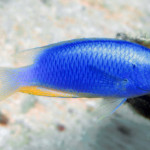
Pomacentrus micronesicus – new damselfish species from Micronesia
Picture above Courtesy of Jeanette Johnson. Liu et al. Zoological Studies 2013 52:6 doi:10.1186/1810-522X-52-6
Say hello to Pomacentrus micronesicus, a newly described species of blue damselfish! It has been given the name Pomacentrus micronesicus since is was found in Micronesia.
The new species was identified by Shang-Yin Vanson Liu (National Taiwan University), Hsuan-Ching Hans Ho (University of California) and Chang-Feng Dai (National Dong Hwa University). The full report “A new species of Pomacentrus (Actinopterygii: Pomacentridae) from Micronesia, with comments on its phylogenetic relationships” has been published by Zoological Studies and can be found here.
Cryptic species
There are plenty of known species of blue damselfish already, and now the Micronesian damselfish Pomacentrus micronesicus has been added to the mix. It looks very similar to several other species of blue damselfish, but the presence of only a light yellow coloration on the ventral fins and tail can help us a bit when it comes to distinguishing the Micronesian damselfish from other similar species of blue damselfish. There are also a few other things to look for, which you will find more information about further down on this page.
Marine organisms that look extremely similar but are actually genetically distinct are known as cryptic species. Thanks to new techniques for DNA sequencing, it has become possible for researchers to test if two similarly looking specimens are genetically distinct or not. This is what Vanson Liu, Hans Ho and Dai did to the fish they collected off the cost of the Marshall Islands, and this is how they were able to confirm that they had encountered a new species of damselfish.
Where does this species live?
The 21 specimens of Pomacentrus micronesicus collected for the study lived around the Marshall Islands in Micronesia, in the western Pacific Ocean.
The holotype was found near the Kwajalein Atoll (9°11′2.87″N, 167°25′4.88″E), at a dept of 5-10 meters. It was hand netted by Scott Johnson on August 2, 2009.
What does a Micronesian damselfish like?
No specimens longer than 30 mm has been found so far. Pomacentrus micronesicus is metallic blue both anteriorly and dorsally, with a light yellow ventral portion. The dorsal fin has the same metallic blue color, while the pectoral fin (including the soft ray of the pectoral fin) is of a light blue shade. The pelvic fin is light blue to yellow, with a blue anterior margin. The anal fin is also light blue to yellow, and has a blue margin, but is in addition to this adorned with small blue spots. The caudal fin is light blue to yellowish, with a few blue spots on the anterior portion.
Pomacentrus micronesicus has a deeply forked caudal fin with a relatively long filamentous upper lobe. The body is ovate and slightly elongated. The mouth is terminal, small and oblique and forms an angle of about 40° to 60° to the horizontal axis of the head and body.
How can I distinguish between Pomacentrus micronesicus and Pomacentrus colestis?
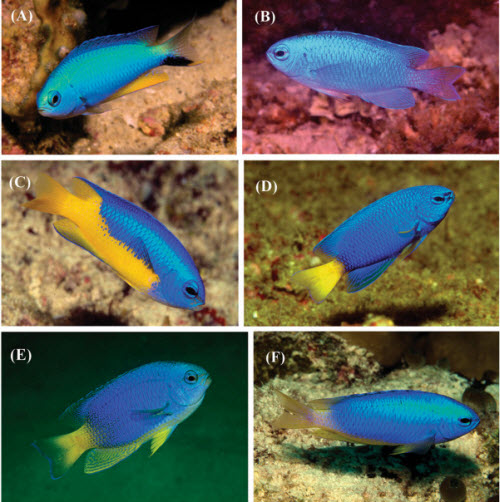
Photographs of the P. coelestis complex. (A) P. alleni, Weh Island, Sumatra, Indonesia. (B)P. coelestis, Nusa Kode, Komodo Islands, Indonesia. (C)P. auriventris, Raja Ampat Islands, Indonesia. (D)P. similis, Mergui Archipelago, Myanmar. (E)P. caeruleus, Andavadoaka, southwestern Madagascar. (F)P. micronesicus sp. nov., Chuuk, Federated States of Micronesia. Courtesy of GR Allen.
Liu et al. Zoological Studies 2013 52:6 doi:10.1186/1810-522X-52-6
P. micronesicus and P. colestis looks very similar to each other, but there are a few differences that can be useful for the reef aquarium keeper.
- Pomacentrus micronesicus tend to have a lower body depth than Pomacentrus colestis.
- Pomacentrus micronesicus usually has 15 rays on the anal fin while Pomacentrus colestis usually has just 14 rays.
- Pomacentrus micronesicus has 15 or 16 rakers on the lower limb of the first gill arch. Pomacentrus colestis has 13-14 rakers.
- Pomacentrus micronesicus has a total of 20-23 gill rakers on the first gill arch. Pomacentrus colestis only has 18-21 rakers.
- Look at the caudal fin of your fish. Pomacentrus micronesicus usually has a filamentous upper lobe that is deeply concave. Although this can occur in Pomacentrus colestis too, it is much less common.
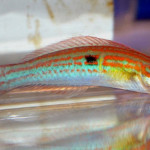
Minute wrasse – Minilabrus striatus – new species available at ACI Aquaculture
The Minute wrasse is a small colorful wrasse that can reach 2.5 inches / 6 cm in length. It is the only species in its genus and its small size makes it a perfect fit for small marine aquariums and marine aquarium with sensitive invertebrates in them. The species is reef safe but can eat small invertebrates. It should not be kept with larger fish. The Minute wrasse is a schooling species and should as such never be kept alone. It originates from the south and central parts of the red sea.
The minute wrasse that is now available at ACI Aquaculture is very rare in the aquarium trade and this might be the first time it has been imported to the USA. This is a shame since it is a stunning little gem that would make a wonderful addition to our aquariums.
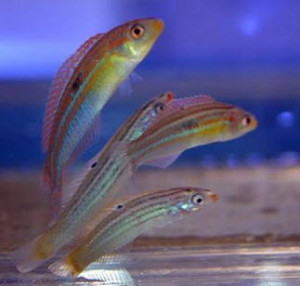 The species is according to my own observations plentiful in the wild in the red sea and the population should support a more widespread harvesting for the aquarium trade if it were to become a more popular species. In the red sea it lives in shallow waters, usually less than 36 ft / 12 meters deep. They are usually found in large groups at reef slopes. They are prominently found on the outher reef slopes but can from my observations be found anywhere on the reef where there is a drop of point. They are usually especially plentiful near caves at the outer reef slopes.
The species is according to my own observations plentiful in the wild in the red sea and the population should support a more widespread harvesting for the aquarium trade if it were to become a more popular species. In the red sea it lives in shallow waters, usually less than 36 ft / 12 meters deep. They are usually found in large groups at reef slopes. They are prominently found on the outher reef slopes but can from my observations be found anywhere on the reef where there is a drop of point. They are usually especially plentiful near caves at the outer reef slopes.
This species is as earlier mention best kept in groups but due to the limited numbers that have been collected and brought to the USA at this time it will be virtually impossible and cost prohibitive to to get a whole group. We would despite this like to recommend that anyone who is interested in this fish get at least 2 or 3. You will enjoy them a lot more and it also raises the possibility of breeding this species. Captive breeding on this species is highly desirable since it could make an excellent addition to our hobby.
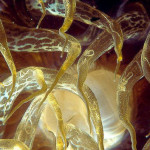
Aiptasia Anemones
What is Aiptasia
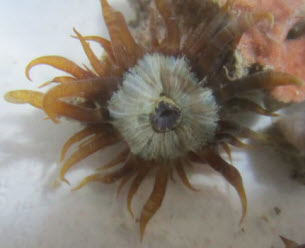
Aiptasia anemone. Picture by Smithsonian Institute.
Aiptasi sp is a type of pest anemone that infest reef aquariums and it should although beautiful be removed from an aquarium as soon as possible. The longer it takes to start treatment the worse the infection will be. Aiptasia is most often introduced to an aquarium with live rock. The most common species in aquariums is Aiptasia pallida but other species are also regularly introduced.
It is common that beginner reef keepers anxiously is observing their live rock to see what types of life it might have brought with it. One day they see a small baby polyp. The right thing to do at this point is usually to remove it since most polyp hitch hikers are either Aiptasia or the equally problematic Majano Anemone. Most reef keepers do however want to see what it develops into and before long they are the happy owners of a beautiful anemone. Fast forward in time and the reef keeper will before he knows it have a rapidly growing Aiptasia colony and start to realize that he has a problem. At this time it is a lot harder to get rid of the Aiptasia than it would have been if it had been removed straight away. It is therefore important to try to identify any polyp and anemone you see as early as possible. You can read more about identifying Aiptasia further down in the text.
In the wild Aiptasia is a common sea anemone found in temperate and tropical waters. They live in the benthic zone where they can be found growing on mangrove roots and hard surfaces. Many species of Aiptasia contain symbiotic dinoflagellate unicellular algae of the genus Symbiodinium living inside nutritive cells. The algae helps the Aiptasia by providing fats and sugars produced through photosynthesis. In return the Aiptasia provides protection and inorganic nutrients. Some species that feeds on Aiptasia such as the Berghia nudibranch absorbs these algae and benefit from the symbiotic relationship. The algae do however normally survive less than one week after having been absorbed by Berghia nudibranches.
Aiptasia species are hardy and beautiful but they are still considered aquarium pests and it is easy to see why. The Aiptasia is very fast growing and aggressive. If left alone they can quickly out compete everything else living on the live rock. They have stinger cells (filled with nematocysts ) filled with a very potent poison that cause corals and other polyp animals to retreat The Aiptasia is also capable to kill corals, shrimp, crabs, snails and even fish. It is not very common that Aiptasia kills fish or desirable invertebrates but the risk is more than serious enough to warrant their immediate removal and the risk get higher the more the Aiptasia is allowed to spread. Aiptasia stings for both offensive and defensive purposes.
Aiptasia is very hard to remove once established due to their ability to regrow from very small segments left on the rock after the removal of the poly. Each of the small segment regrows into a new polyp. Aiptasia can sometimes regrow from one single cell left on the substrate after the removal of the rest of the polyp.
Identifying Aiptasia
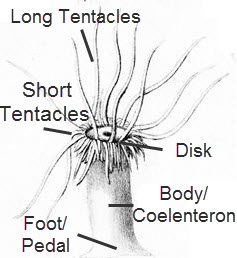 It is important to identify Aiptasia as early as possible so that treatment can start as early as possible. It is also very important to identify Aiptasia correctly if you want to use biological methods to control the Aiptasia. Berghia nudibranches will as an example only eat Aiptasia and not Majano Anemones. Another type of very common aggressive pest anemone.
It is important to identify Aiptasia as early as possible so that treatment can start as early as possible. It is also very important to identify Aiptasia correctly if you want to use biological methods to control the Aiptasia. Berghia nudibranches will as an example only eat Aiptasia and not Majano Anemones. Another type of very common aggressive pest anemone.
It can be hard to identify Aiptasia and other polyps while they are still small but once they are fully formed it gets a lot easier. It can however sometimes still be a challenge.
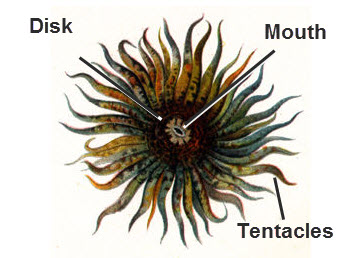 Aiptasia species looks like small palm trees with a disk of tentacles at the top. The disc contains both long and short tentacles attached at the edges of the disc. In the center of the disk is the mouth. It looks like an elongated slit. The tentacles are usually slender and have very pointed tips. If the tentacles are more chubby with bulbous tips you are most likely looking at the similar but very different Majano pest anemone. The “stalk” or the coelenteron (polyp body) as it is more correctly called of the Aiptasia can grow up to 5 cm / 2 inches long. The disk at the top can grow to be 2 cm / 3/4 inch wide.
Aiptasia species looks like small palm trees with a disk of tentacles at the top. The disc contains both long and short tentacles attached at the edges of the disc. In the center of the disk is the mouth. It looks like an elongated slit. The tentacles are usually slender and have very pointed tips. If the tentacles are more chubby with bulbous tips you are most likely looking at the similar but very different Majano pest anemone. The “stalk” or the coelenteron (polyp body) as it is more correctly called of the Aiptasia can grow up to 5 cm / 2 inches long. The disk at the top can grow to be 2 cm / 3/4 inch wide.
The coloration in the Aiptasia is caused by the dinoflagellate alga living in it. The color of the Aiptasia will hence vary with the lighting conditions under which it grows. In a well lit area Aiptasia will usually be dark to greenish brown. The tone of the Aiptasia will grow lighter the less light that is provided. This can give them a tan or even almost transparent look in low light conditions. It is common that the body of the Aiptasia features lightly marked parallel lines. These lines are however not always present. It is also not uncommon that white or light green flecks are present near the tentacles. Juveniles specimens can sometimes be entirely cover in flecks.
Aiptasia Species
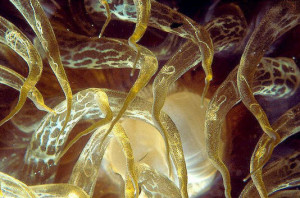
Aiptasia mutabilis – Picture also used in article header.
© Alfiero Brisotto cc2.0
The following 16 species of Aiptasia is currently accepted:
- Aiptasia californica (Carlgren, 1952)
- Aiptasia carnea (Andrès, 1881)
- Aiptasia diaphana (Rapp, 1829)
- Aiptasia erythrochila (Fischer, 1874)
- Aiptasia insignis (Carlgren, 1941)
- Aiptasia inula (Duchassaing & Michelotti, 1864)
- Aiptasia leiodactyla (Pax, 1910)
- Aiptasia mimosa (Duchassaing & Michelotti, 1864)
- Aiptasia minuta (Verrill, 1866)
- Aiptasia mutabilis (Gravenhorst, 1831)
- Aiptasia pallida (Agassiz in Verrill, 1864)
- Aiptasia parva (Carlgren, 1938)
- Aiptasia prima (Stephenson, 1918)
- Aiptasia pulchella (Carlgren, 1943)
- Aiptasia saxicola (Andrès, 1881)
- Aiptasia tagetes (Duchassaing & Michelotti, 1864)
Aiptasia Care
There are a number of reason to actively keep and care for Aiptasia. The most common reason is likely as food if you are breeding Berghia nudibranches. Berghia only eat Aiptasia and is commonly sold to control Aiptasia
If you for some reason want to actively keep and care for Aiptasia you will find it to a be a very easy and hardy anemone. That is the reason they are considered a pest. It will not require any special care to grow as long as you keep decent water quality. I do not recommend keeping any other small fish or invertebrate in aquarium where you plan to grow Aiptasia. There is always a risk that they will get killed.
Acquiring Aiptasia can sometimes be hard since no one want to have it in their aquarium. It should however usually not be to hard to get some from an infested aquarist or aquarium store. Worst case scenario you might be able to get some from one of the many Berghia sea slug breeders that sell their slugs online.
Avoid keeping species that are known to eat Aiptasia such as peppermint shrimp and butterfly fish if you want to keep Aiptasia in your aquarium.
Aiptasia Reproduction
Aiptasia can reproduce both sexually and asexually.
- Asexual reproduction
Asexual takes place through pedal laceration. This happens when a small group of cells are somehow separated from the pedal disk of the Aiptasia. These small groups of cells grows into buds. These buds will then develop mouths and tentacles of their own. A miniature Aiptasia is normally formed within a week or two from the cells being separated from the parent polyp. This polyps can release their grip on the surface and float with the waters current to colonize a new spot. Colonies of Aiptasia form and grow primarily through asexual reproduction. Sexual reproduction play a larger role in spreading them to new locations. Aiptasia can as earlier mentioned regenerate an entire new anemone from a single cell. This is why they are so hard to eradicate and why methods that only destroys the polyp without killing all the cells such as manual Aiptasia removal are so contra productive.A surprising ability in at least some Aiptasia species (A. diaphana) is that pedal laceration can produce both male and female polyps. In other words, even though the new polyps created through asexual reproduction are clones of the original poly they can still developed into different sexes. Clones can reproduce with each other through sexual reproduction. Some clones have even been shown to develop into hermaphroditic polyps. - Sexual ReproductionThe Sexual reproduction in Aiptasia works different in different species. Some species such as the common Aiptasia pallida and Aiptasia pulchella have external fertilization. Other species supposedly have internal fertilization that takes places within the Aiptasia.Lets start by having a look on sexual reproduction in Aiptasia species such as Aiptasia pallida and Aiptasia pulchella. The reproduction in these species are well researched. The Aiptasia belong to one of two genders. The two genders release their gametes into the water where the fertilization occurs. The resulting zygote turns into free swimming planula larva. These free swimming planula larva flows with current for a while before they settle down on a hard substrate. Once they have attached themselves they grow and metamorph into tiny polyps. The symbiotic dinoflagellate alga found in Aiptasia is absorbed into the tiny polyp from the water.Lets now look on internal fertilization in Aiptasia. This is believed to occur in some species but I have been unable to find an concrete scientific evidence or documentation to verify this. It is however know that some species of anemones are capable of internal fertilization so it would not be surprising if the reproductively very versatile Aiptasia genus contained species that is capable of internal fertilization. Internal fertilization takes places when the male Aiptasia release their sinking gametes into the water. They settle down and fertilizes the gamets within the coelenteron of a female Aiptasia. Planula Larva are then developed and grows within the Aiptisia. The Planula Larva are released when the conditions are right or if the mother polyp is attacked. They then go on to colonize new locations on the reef.
Aiptasia will reproduce more asexually during poor conditions such as when under attack from predators, during poor lighting, in low oxygen situations etc. During good conditions they reproduce more sexually. In the wild there is also evidence that the season affects the preferred reproduction method in Aiptasia. Many chemical Aiptasia remedies also causes increased asexual reproduction.
References
Schlesinger A, Kramarsky-Winter E, Rosenfeld H, Armoza-Zvoloni R, Loya Y (2010) Sexual Plasticity and Self-Fertilization in the Sea Anemone Aiptasia diaphana. PLoS ONE 5(7): e11874. doi:10.1371/journal.pone.0011874
http://lanwebs.lander.edu/faculty/rsfox/invertebrates/aiptasia.html
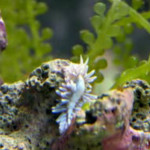
Berghia (Aeolidiella) Nudibranch – Natural Aiptasia Control
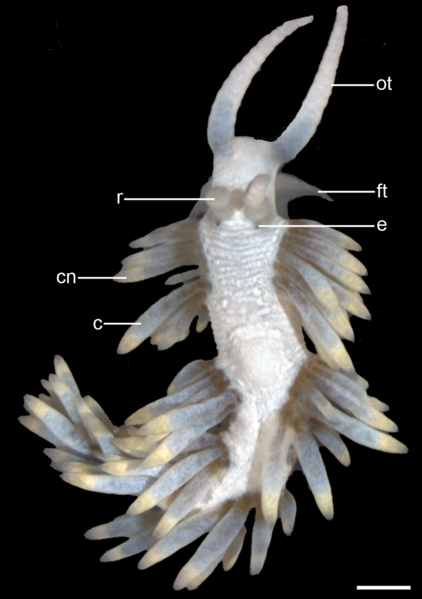
Aeolidiella stephanieae
ot = oral tentacles,
ft = foot tentacles
e = eye,
r = rhinophores,
cn =cnidosacs at the cerata tips.
c = cerata.
Picture by: Alen Kristof & Annette Klussmann-Kolb
Aiptasia can be a big problem in a reef tank and there are plenty of different methods available for getting rid of Aiptasia ranging from chemical products to spot application with lemon juice. Click to learn more about Aiptasia and how to get rid of Aiptasia. In this article we are going to focus on the Berghia nudibranch and how it can be used to exterminate Aiptasia from your reef.
Berghia (Aeolidiella) Nudibranch
The Berghia nudibranch is a small nudibranch that is commonly kept in aquariums to control Aiptasia, a type of pest anemone. In is the most commonly kept and sold sea slug in America. Almost all sold specimens are bred in captivity.
The Berghia nudibranch grows to be no more than 20 mm in length and has a soft sensitive body. This species should not be handled more than necessary since it is very easy to harm these fragile creatures.
The Berghia nudibranch kept in aquariums is native to waters around Southern Florida and the Florida keys where it is found in shallow water. It is only one of many species of Nudibranches that eat Aiptasia. It is however the only species of Aiptasia eating sea slug common in the aquarium trade.
Aeolidiella stephanieae not Berghia verrucicornis
The Berghia nudibranch is called the Berghia Nudibranch because it was believed that the Sea slugs kept in aquariums belonged to the species Berghia verrucicornis. This is however not the case. The species commonly kept in aquariums as the Bergia nudibranch or the Berghia sea slug is actually Aeolidiella stephanieae, another species belonging to the same family (but another genus). Aeolidiella stephanieae was described by science in 2005 (Valdés A. (2005). “A new species of Aeolidiella Bergh) . The Berghia nudibranch should in other words more correctly be called the Aeolidiella nudibranch. The common name Berghia nudibranch have however stuck in the trade due to the fact that it had been used for a long time before the sea slug was re-categorized as a new species.
It is not unlikely that it in time will be discovered that there actually is several similar looking species of Berghia nudibranches kept in aquariums to control Aiptasi. I am basing this statement on differences described from observations of the life cycle and reproduction of different nudibranch populations kept in aquariums. Another factor that suggest that there might be several species kept in the aquarium trade is that Aeolidiella stephaniea is said to reach a maximal length of 20 mm, less than one inch while some Berghia Nudibranch populations kept in aquariums reach up to 1 ½ inch in length. Almost twice the length of Aeolidiella stephanieae. It is however also possible that these differences are due to from different environmental factors or that there is different populations originating from different collection sites with different behavior and size although belonging to the same species.
Scientific classification
Kingdom: Animalia
Phylum: Mollusca
Class: Gastropoda
Family: Aeolidiidae
Genus: Aeolidiella
Species: stephanieae
Berghia Life Cycle
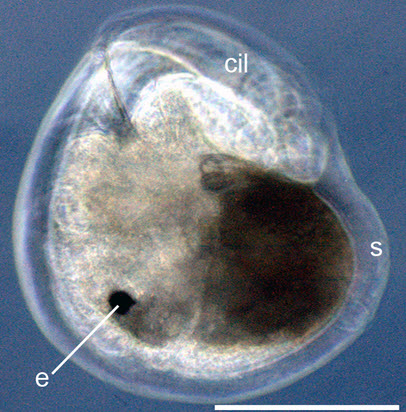
larva in metamorphosis (25% of development) of Aeolidiella stephanieae. Scale bar is 100 μm.
e = eyes
cil = cilia
s = shell.
Picture by:Alen Kristof & Annette Klussmann-Kolb
The Berghia has a rather short life cycle. Their development from egg to sexual mature adult takes a mere 60 days at 22°C / 72°F. Warmer temperatures makes them develop faster. Colder water slows down the development. The eggs hatch after about 10-14 days. Some eggs hatch as fully metamorphosed sea slugs and can start searching for food right away. Other eggs hatch in to larvae that float in the water for about 24 hours before they settle down and start their metamorphosis. The metamorphosis usually take about 48 hours and the juvenile Berghia sea slugs usually start crawling looking for food around 24 hours after the metamorphosis. They are usually actively feeding 48 hours after metamorphosis. Juvenile Berghia are usually about 600 microns long when they start feeding actively. The Berghia nudibranch can live about 10 months with a good food supply.
Keeping Berghia Sea Slugs
Berghia (Aeolidiella stephanieae) is easy to keep and care for in a reef aquarium as long as there is food, Aiptasia, to eat and the water quality is kept high and stable (<25ppm of nitrates, 0 ammonia and 0 nitrites). They will do well in most established reefs aquarium. Do not get too worried if you do not see much of your Berghia. They are small, primarily nocturnal and in some aquariums with a lot of corals and live rock you might hardly ever see any. If you want to spot them I recommend that you use a flash light to light up Aiptasia infested areas during night time. If your Sea slugs are introduced to the tank correctly you should start to see a reduction in the amount of Aiptasia in a couple of weeks.
Berghia are very small and add a very small bioload to your tank.
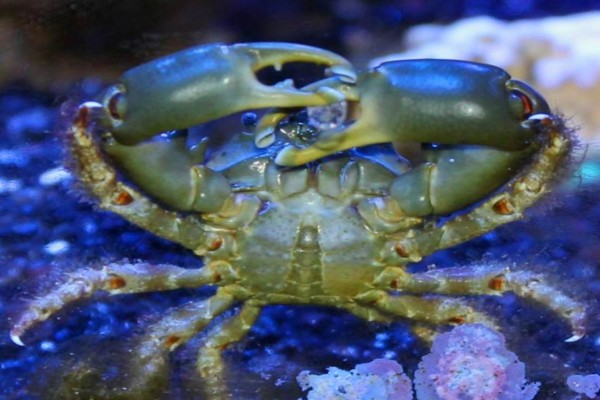 It is important to remember that just because a fish or invertebrate is reef safe it does not mean that they will not eat Berghia sea slugs. Many popular fish species do sometimes eat them including some wrasses, filefish, butterfly fish and dottybacks. This is not a complete list of fish that might eat Berghia and it is important that you keep an eye on your tank to see if your sea slugs are being left alone. There is also a lot of invertebrates that will eat them including emerald crabs, sally lightfoot crabs, arrow crabs, pom pom crabs and peppermint shrimps. Emerald crabs seldom eat Berghia if there is plenty of algae around for them to eat.
It is important to remember that just because a fish or invertebrate is reef safe it does not mean that they will not eat Berghia sea slugs. Many popular fish species do sometimes eat them including some wrasses, filefish, butterfly fish and dottybacks. This is not a complete list of fish that might eat Berghia and it is important that you keep an eye on your tank to see if your sea slugs are being left alone. There is also a lot of invertebrates that will eat them including emerald crabs, sally lightfoot crabs, arrow crabs, pom pom crabs and peppermint shrimps. Emerald crabs seldom eat Berghia if there is plenty of algae around for them to eat.
The fact that peppermint shrimp eat Berghia can be a problem since peppermint shrimp often are added to aquariums to control and eat Aiptasia in reef aquariums. They do however enjoy eating berghia and will therefore need to be removed from the tank before you add the sea slugs. Peppermint shrimps are easy to remove using a trap constructed from a PET bottle. Simple cut the top of the bottle and but it back in backwards to create a entrance that becomes more narrow as they go into the trap. Shrimps will find their way out of the trap if you give them enough time so you will need to to check on and empty the traps on a more or less hourly basis. It is not a problem if you leave it longer but it can take longer before you catch all the shrimp if you do.
It is not uncommon for the Berghia to start breeding in your tank. This is nothing that you have to worry about since most of the eggs will be eaten and the population will only grow as the Aiptasia infestation allow. The slugs will start dying of when the Aiptasia has been removed. They can live for 5-7 days once the Aiptasia has been removed.
Berghia sea slugs only eat Aiptasia. There is no point trying to feed them anything else. They get their color from the Aiptasia they eat. They absorb the pigment from the Aiptasia. If you see Berghia that are completely white than this mean that they haven’t eaten in 24 hours. This means that their either is no more Aiptasia in their tank or (in a large tank) that they cant find them. If this is the case you can help the sea slugs by moving them to the Aiptasia. Remember that they are fragile.
It is important that to remember that they will start dying of once the Aiptasia has been eradicated and that this can cause some stress on the water. If you see an ammonia spike at this point than you know that dying sea slugs are the like reason. It can for this reason be good to reintroduce your peppermint shrimps to the tank 2-3 days after you saw the last Aiptasia. Or ideally 24 hours after your Berghia turns white. (IE haven’t eaten in 24 hours) They can then eat some of the sea slugs before they die of. The Berghia die off will however normally not cause a big problem since they are very small and you should only have a small number of them.
Introducing Berghia to your tank
Berghia nudibranch can be rather sensitive when first introduced to a new aquarium and it is important that you acclimatize them well. They should be drip acclimatized for at least two hours before they are put into their new tank. Keep an eye on them during the entire acclimatization process.

Aiptasia anemone. Picture by Smithsonian Institute.
If you acquired your Berghia Nudibranches by ordering online they might not have eaten for at least 10-14 hours (sometimes longer) when they arrive in your home. It can therefor be a good idea to feed them during the acclimatization process. Put a small part of Aiptasia in the bag.
Berghia sea slugs are very sensitive to touch and you should never try to move them into the tank by touching them. There is a great risk that you end up damaging them. The best way to move them into your tank is to use a suitable sized pipette and place them directly on the rock in the vicinity of Aiptasia so that they easily can find food.
Turn of the light and filtration system before introducing the slugs. This will give them the ideal conditions to settle in and grab hold of the live rock. It will also make it easier for them to find the Aiptasia. You can turn the light and filter back on one hour after you introduced them.
Aiptasia will eat these sea slugs if they end up in the mouth area of the Aiptasia. It is therefore very important that you make sure not to put the Berghia directly on the Aiptasia when you introduce them to the tank.
Breeding Berghia Nudibranches
Berghia Nudibranches are easy to breed if you keep them in an aquarium with good stable water quality. They will commonly breed in reef aquariums while being used for Aiptasia control. Since you are reading this text we will however assume that you want to breed Berghia on a more productive and more long term level than simply having them spawning in your main tank. The best way to achieve this is to have a tank where you only keep Aiptasia and Berghia (Aeolidiella stephanieae).
The main problem when breeding these Nudibranches is that you need a stable access to Aiptasia anemones since that is all they eat. The Berghia sea slugs are likely to eat all the Aiptasia in the breeding tank so you will need on or two other tanks for growing Aiptasia as food.
Berghia Nudibranches are hermaphroditic but are not capable of asexual reproduction. In other words they are both male and female but need to mate with another specimen to reproduce. Each Berghia will produce between 1000 to 2000 eggs per batch. Almost all eggs will be fertilized. You can read more about the development of the eggs by reading above under Berghia life cycle. It normally takes between 4-6 weeks before you can see the juvenile Berghia with the naked eye.
Using Berghia to control Aiptasia

Bergia Eating Aiptasia. Watch the video
Berghia is one of the best ways of getting rid of and controlling Aiptasia in a natural way. The sea slugs will find the smallest part of Aiptasia and eat them leaving no trace of them in your tank. You do not have to worry about them growing back unless you reintroduce them into the tank somehow.
Berghia Nudibranches have evolved methods of approaching the Aiptasia that prevent the defensive mechanics of the Aiptasia to kick in. Aiptasia will not attack with their stinger cells nor release planula larva into the water when Berghia slugs approach like they do when other dangers approach. It is believed that this is caused by a the chemical composition of their mucus.
The Berghia nudibranch is able to find all Aiptasia regardless of size using organs called rhinophores and this guarantees that all Aiptasia will be eradicated. Not just larger visible specimens.
It is important to make sure that your aquarium is infested with Aiptasia and not Majano Anemones before you get Berghia. Berghia sea slugs only eat Aiptasia, they do not eat Majano. Both are common pest anemones but the Majano have shorter more stubby tentacles. The tentacles on Aiptasia is longer and more slender.
Berghia can not get into filters and other equipment. It is therefore important that you clean these areas to make sure that no Aiptasia is hiding there.
These sea slugs are not suitable to treat light infestation (less than 10 polyps) in large tanks over 30 gallons. There is a risk that the Berghia will starve before they can find all Aiptasia.
https://www.youtube.com/watch?v=5caLVzwM-1g
Why it is better to use Berghia to control Aiptasia
Aiptasia is according to me the best way of getting rid of Aiptasia. I like that it is a natural method and it avoids a lot of the problems that is associated with other methods. Some of the most important benefits with Berghia are:
- Berghia nudibranch will find all the Aiptasia in the tank. Even the ones hidden in crevices or too small for the aquarium owner to see and spot treat against.
- Chemical treatments are often sold as reef safe despite containing chemicals that are harmful to other marine life. It might not kill them but it will still disturb their biological processes. For this reason I prefer not to use any chemicals in my aquariums if not absolutely necessary. In the case of Aiptasia it is not because there is a better biological solution.
- Chemical treatments causes the Aiptasia to die more or less all at once. This causes a lot of stress on the water. When you spot treat you can to a degree lessen this problem by treating different patches of Aiptasia at different times but you still get an entire patch dieing all at once and polluting the water. Using Berghia you do not get the water pollution problems since the Aiptasia is slowly consumed over a couple of months.
- When the Aiptasia is gone you know it is gone. The sea slugs will not miss any Aiptasia and you do not have to worry about it growing back.
How many do I need
How many Berghia snails you need to control and eradicate the Aiptasia in you tank depends on how severe the infestation is. You should usually have 8-10 slugs per 100 gallons of water but if you have very severe infestation (more than 100 Aiptasia per 100 gallon) you might want to consider a higher number of snails.
How long does it take
Berghia snails is not a quick solution to Aiptasia control. It is however a natural method that will be able to remove all Aiptasia. The ones you see and the ones you do not see. It usually take a couple of weeks before you start seeing a noticeable difference. In 2-3 months the tank should be completely free of the infestation. Berghia is a great way of getting rid of Aiptasia without having to use chemicals.
References:
Valdés A. (2005). “A new species of Aeolidiella Bergh, 1867 (Mollusca: Nudibranchia: Aeolidiidae) from the Florida Keys, USA”. Veliger 47(3): 218-223.
Felder, D.L. and D.K. Camp (eds.), Gulf of Mexico–Origins, Waters, and Biota. Biodiversity. Texas A&M Press, College Station, Texas.
WoRMS (2013). Aeolidiella stephanieae Valdés, 2005. Accessed through: Tunnel, W.; Moretzsohn, F. (2013) Gulf of Mexico register of marine species at http://www.marinespecies.org/aphia.php?p=taxdetails&id=389717
Lightning clownfish fry
It is a big day for all clownfish lovers and especially those who hope to keep a lightning clownfish sometimes in the future. Not too long ago we reported on what ultimately turned out to be a failed spawning of the Lightning clownfish. Well a few days ago the pair spawned again and this time they didn’t eat their eggs. A few hours ago the first eggs hatched and the remaining ones where moved to a dedicated Black Round Tub for artificial hatching. There are still some challenges before we get to see lightning clownfish fry and there is no guarantee that the pair will produce Lightning clownfish fry but with a little bit of luck we will see lightning patterned fry before we know it that can be passed on to other breeders that can help this wonderful type of PNG clownfish spread in the hobby.
Go to lightning-maroon-clownfish.com/ for the latest news about the fry and the breeding efforts. You can see the hatching announcement here.
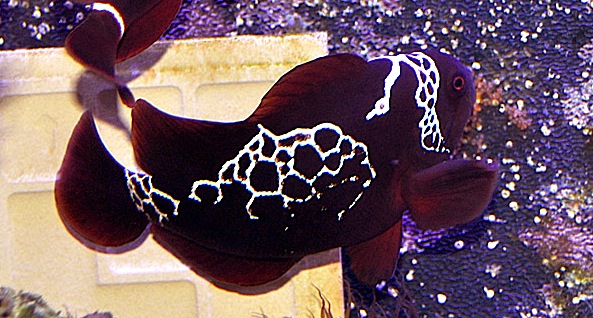
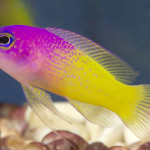
Bicolor basslet, Lipogramma klayi, bred by Todd Gardner
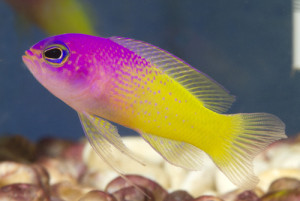 Todd Gardner at the Long Island Aquarium has added another first to the long list of species that was first bred at the aquarium. Todd successfully breeds and raised the larvae of the expensive deep water bicolor basslet, Lipogramma klayi. The stunning fish has been dropping in price over the last few years and can now be bought for under USD1000.This is in large part due to the Curacao Aquarium Submarine being able to catch them in larger numbers than before. It is however far from a cheap fish and there is no doubt that aquaculture of this fish is a worthwhile goal as more aquarists deserves to get to know this little beauty. Continue reading
Todd Gardner at the Long Island Aquarium has added another first to the long list of species that was first bred at the aquarium. Todd successfully breeds and raised the larvae of the expensive deep water bicolor basslet, Lipogramma klayi. The stunning fish has been dropping in price over the last few years and can now be bought for under USD1000.This is in large part due to the Curacao Aquarium Submarine being able to catch them in larger numbers than before. It is however far from a cheap fish and there is no doubt that aquaculture of this fish is a worthwhile goal as more aquarists deserves to get to know this little beauty. Continue reading
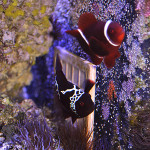
The lightning maroon clownfish finally spawned!!!
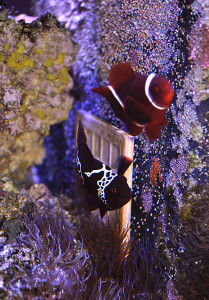
By: Matt Pedersen
Yes you read right. Matt Pedersen little “doubling down“ trick to get them to spawn that we wrote about here seems to have worked and the lightning maroon clownfish has finally spawned after 2 years of trying. This is very good news for all those who hope to keep these stunning fish one day, myself included.
Matt has been trying to get them to breed for two years now pairing it with a number of other maroon clownfish of both sexes. Finally it paired with a smaller maroon clownfish and this morning matt could finally report that they had spawned for the first time. (read the full story here.) It is a bit early to get too excited since it is common for the first spawns to fail and to produce where few fertile eggs but once a clownfish pair start to spawn they usually continue doing so. Matt should hopefully soon have a number of lightning clowns to breed from and pass on to other successfully breeders so that they can help this clown fish become more available. This clownfish really deserves to become a common sight in aquariums around the worlds and the chances of that happening greatly increased today.
Until today only two lightning maroon clownfish was ever caught, both in the waters of Papua New Guinea. Just a few weeks ago a third fish was caught in the same waters that resembles the lightning maroons but with a much less distinct pattern. See the image below. This latest catch was aquired by EcoReef UK
